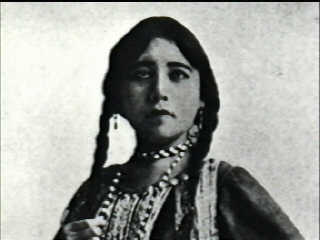Authors:
Historic Era: Era 7: The Emergence of Modern America (1890-1930)
Historic Theme:
Subject:
April 1996 | Volume 47, Issue 2


Authors:
Historic Era: Era 7: The Emergence of Modern America (1890-1930)
Historic Theme:
Subject:
April 1996 | Volume 47, Issue 2

They had been driven back and hemmed in by gun and telegraph and railroad and barbed wire, and in the end it was upon dreams, trances, and visions that they were forced to rely. So, by the hour and the day, they danced the Ghost Dance, which they wanted to believe would give life to their dead, send whites away, bring back the lost buffalo herds.
It was quite terrifying to the whites: thousands of Indians across vast spaces chanting, singing, dancing. When Big Foot’s band was pushed into South Dakota’s Pine Ridge Reservation, at Wounded Knee Creek, the soldiers of the 7th Cavalry Regiment, Custer’s old outfit, kept their fingers on their triggers. A fracas broke out. It was December 29, 1890. Someone fired a shot. At once, the troops opened up, Hotchkiss guns throwing shrapnel. The Indians ran. The soldiers followed. By a little hollow of rolling hill in prairie grasslands a trooper put two rounds into the breast of an Indian mother. She burrowed into the hollow. Snow came. At times, the temperature dropped to forty below. Four days and three nights later a burial party heard an infant’s cries. The mother whose body had sheltered and shielded her daughter was dropped into a mass grave along with others similarly frozen solid, some 150 of them.
The baby lived. She had on her little wrist a bracelet, and she wore moccasins. On her head was a hide cap decorated in beads with the American flag. An old woman of the Lakotas named her Zintkala Nuni, “Lost Bird.” To the newspapers, swiftly doubtful about the righteousness of this last act of the long fight between the red and white races—for there would never be another, this was the end—she was the “little heroine,” the “little dusky maid” who was an “Indian princess.” Her situation came to the attention of Leonard Wright Colby, a brigadier general of the Nebraska National Guard, which had been hurried to what was originally termed the Battle of —but soon came to be known as the Massacre of —Wounded Knee. This infant could be, he said, “a most interesting Indian relic.” Colby decided he wanted this “curio.” He would adopt her; she would become his “protégé,” this “Ghost Dance baby.” He appropriated the girl, took her home, made out adoption papers. Then he informed his wife.
Clara Bewick Colby was in Washington, D.C., where she spent half of each year. An eminence in the women’s suffrage movement, the close associate of Susan B. Anthony and Elizabeth Cady Stanton, she was the editor and proprietor of The Woman’s Tribune , a bimonthly many considered the